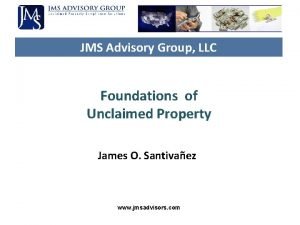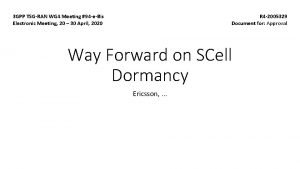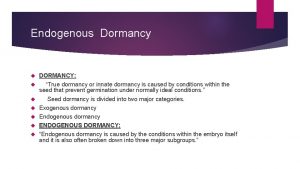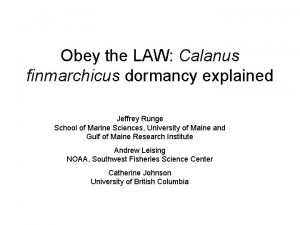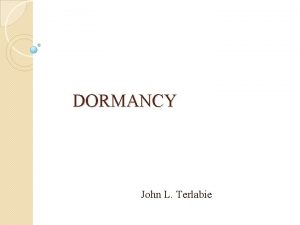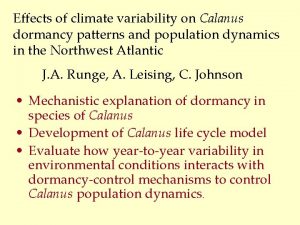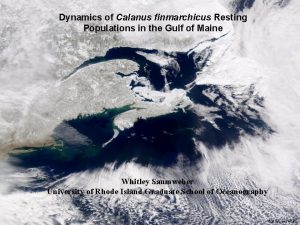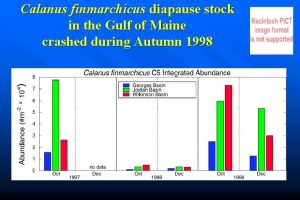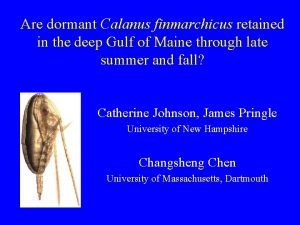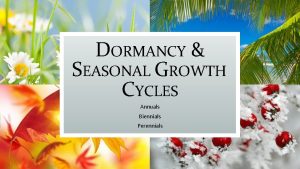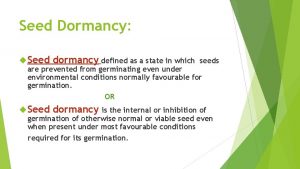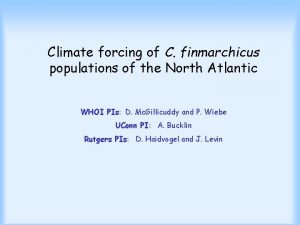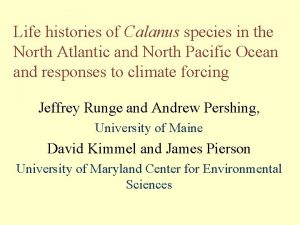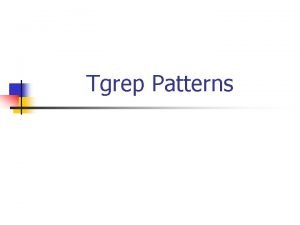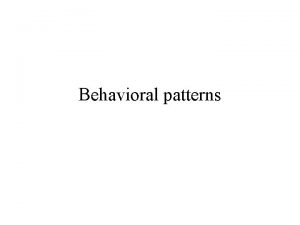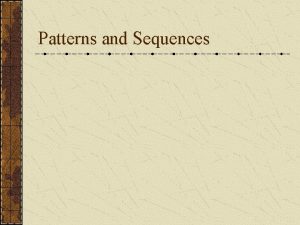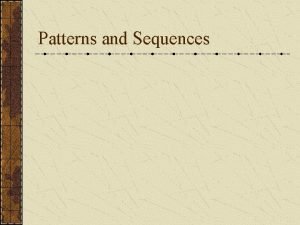Characteristics of Calanus finmarchicus dormancy patterns in the





















- Slides: 21

Characteristics of Calanus finmarchicus dormancy patterns in the northwest Atlantic Catherine Johnson Fisheries and Oceans, Bedford Institute of Oceanography Andrew Leising NOAA, Southwest Fisheries Science Center Jeffrey Runge School of Marine Sciences, U. of Maine and Gulf of Maine Research Institute Erica Head Fisheries and Oceans, Bedford Institute of Oceanography Pierre Pepin Fisheries and Oceans, Northwest Atlantic Fisheries Centre Stéphane Plourde Fisheries and Oceans, Institut Maurice Lamontagne Edward Durbin Graduate School of Oceanography, University of Rhode Island GLOBEC NWA 4 B SI meeting, Woods Hole, 29 Oct 2007

Objectives: • Identify environmental processes that control dormancy in Calanus finmarchicus • Develop a mechanistic understanding of dormancy for inclusion in population dynamics modeling Approach: • Compile Calanus and environmental data across regions in the NW Atlantic • Look for common patterns and cues • Using an individual-based model, test quantitative hypotheses to explain patterns

Data sources Data from: DFO – AZMP: 1999 – 2005 (E. Head, P. Pepin) DFO – IML: 1990 – 1991 (S. Plourde, P. Joly) US-GLOBEC: 1995 – 1999 (E. Durbin, M. Casas) PULSE – NEC: 2003 – 2005 (R. Jones)

Proxies for dormancy entry and exit Entry (Onset) Dormancy Fifth copepodid (CV) half-max proxy Dormant when… CV proportion ≥ x / 2 where x = average max. CV proportion over all years Exit (Emergence) Emergence when… 1. Adult (CVI) proportion ≥ 0. 1 2. Back-calculation from early copepodid appearance, using development time-temperature relationship B. Zakardjian

Abundance (no. m-2) AG: Anticosti Gyre, NW Gulf of St. Lawrence Onset Stage Proportion Emergence

Possible dormancy cues Onset Photoperiod (Miller et al. , 1991) Temperature (Niehoff & Hirche, 2005) Food availability (Hind et al. , 2000) Lipid accumulation (hormonal link? ) (Irigoien, 2004) Emergence Photoperiod (Miller et al. , 1991; Speirs et al. , 2004) Disturbance (Miller & Grigg, 1991) Development (Hind et al. , 2000)

Onset of dormancy ANOVA Parameter Equal variance? F p Year day Y 22. 32 <0. 001 NS≠LSLE, SS; AG≠SS; LSLE≠SS Day length N 18. 38 <0. 001 NS≠LSLE, SS; AG≠SS; LSLE≠SS Temperature at 5 m Y 8. 059 <0. 001 NS≠LSLE, SS; AG≠LSLE, SS Chlorophyll a (0– 50 m) N 2. 427 0. 12 Multiple comparisons Onset NS, Newfoundland Shelf; AG, Anticosti Gyre; LSLE, lower St Lawrence estuary; SS, Scotian Shelf.

Climatological temperature at 5 m Newfoundland Temperature (°C) Anticosti Gyre Onset Emergence Rimouski Scotian Shelf Day of Year

Mean chlorophyll-a, 0 – 50 m Log(chl-a (mg m-3)) Newfoundland Anticosti Gyre Rimouski Onset Scotian Shelf Emergence --- half-saturation [Chl-a] Day of Year

Emergence from dormancy ANOVA Parameter Equal variance? F p Multiple comparisons Year day N 54. 68 <0. 001 AG ≠LSLE; LSLE≠SS Day length N 119. 2 <0. 001 NS≠LSLE; AG≠LSLE; SS≠LSLE Emergence NS, Newfoundland Shelf; AG, Anticosti Gyre; LSLE, lower St Lawrence estuary; SS, Scotian Shelf.

Dormancy duration is not related to deep water temperature during dormancy Dormancy duration is inversely related to surface temperature at onset

Conclusions • No single observed environmental cue explains dormancy patterns • Dormancy entry and emergence occur over a broad range of times, both among individuals and years The mechanistic understanding of dormancy transitions must involve interaction of multiple environmental factors. The lipid accumulation hypothesis is a possible multiplefactor dormancy control mechanism.

Lipid accumulation window hypothesis: Individuals can only enter dormancy if their food and temperature history allows them to accumulate sufficient lipid • Development rate increases faster with temperature than growth rate • Lipid production integrates temporally variable food and temperature history • An additional cue acting prior to stage CV may be required • Mortality also influences probability of reaching CV stage Miller et al. 1977. Growth rules in the marine copepod genus Acartia. L&O. 22: 326 -335.

Calanus IBM overview Growth rate, G: The model groupings C 5 diapause G = gmax * Food / (ks + Food) Where, gmax = b + m*ln (T) Female C 5 C 4 C 1 -3 N 4 -6 N 3 N 1 -2 Egg b and m are empirically fit* DVM Development rate, R: R = Ω* a (T + b) -2. 05 Foraging Behavior a and b are empirically fit Where Ω is a penalty function that decreases development rate at extremely low food levels Mortality: Non-feeding Each stage has a fixed mortality rate (decreasing logarithmically by stage) Copepods also die if their age within stage is greater than that predicted at their minimum allowable T *Data for empirically fit parameters from Campbell et al. (2001), Vidal (1980), and/or Peterson (1986), depending on species

Lipid accumulation window hypothesis: Food index (relative to halfsaturation constant) Decision to enter dormancy in stage CV is made in stage CIV. Criterion is attainment of 30% lipid content by weight

Model objective Identify a dormancy response that allows the model to simulate the seasonal cycle at all stations using the same parameters. Run IBM at four stations using - Climatological temperature and food conditions of each station - Same parameters and dormancy response at all stations

Anticosti Gyre Observed climatology Model simulation males

Rimouski Observed climatology Model simulation males

Next Steps • Test LAW model against C. finmarchicus life cycle data sets in the NW Atlantic. Does the model reproduce variability in individual years? • Test refined and alternative hypotheses - Additional conditions required? • Examine mechanisms for emergence from dormancy: parameterization of metabolic limitation of diapause duration (Saumweber and Durbin, 2006) • Examine influence of climate change scenarios on Calanus life cycle and population dynamics • Further testing with time series observations, include measures of lipid levels in CIV and CV


Individual-based model Lipid fraction (i. e. the fraction of food that goes to lipid) FL = Fmax*Prey/(Ksf+prey) Fmax is the maximum fraction of food that can be allocated to lipid Ksf is a half saturation constant, which is different from Ks *There is a threshold below which FL = 0 Emergence Copepods develop at a reduced rate during dormancy (1/25 th). They emerge either at the end of the slow CV stage or when lipid levels decline to 10%.
 [email protected]
[email protected] Scell dormancy
Scell dormancy Observation of seed germination day by day
Observation of seed germination day by day Dating serves several important functions that include:
Dating serves several important functions that include: Mining frequent patterns associations and correlations
Mining frequent patterns associations and correlations Hình ảnh bộ gõ cơ thể búng tay
Hình ảnh bộ gõ cơ thể búng tay Lp html
Lp html Bổ thể
Bổ thể Tỉ lệ cơ thể trẻ em
Tỉ lệ cơ thể trẻ em Gấu đi như thế nào
Gấu đi như thế nào Chụp phim tư thế worms-breton
Chụp phim tư thế worms-breton Chúa yêu trần thế
Chúa yêu trần thế Môn thể thao bắt đầu bằng từ chạy
Môn thể thao bắt đầu bằng từ chạy Thế nào là hệ số cao nhất
Thế nào là hệ số cao nhất Các châu lục và đại dương trên thế giới
Các châu lục và đại dương trên thế giới Công của trọng lực
Công của trọng lực Trời xanh đây là của chúng ta thể thơ
Trời xanh đây là của chúng ta thể thơ Cách giải mật thư tọa độ
Cách giải mật thư tọa độ Phép trừ bù
Phép trừ bù độ dài liên kết
độ dài liên kết Các châu lục và đại dương trên thế giới
Các châu lục và đại dương trên thế giới Thể thơ truyền thống
Thể thơ truyền thống
